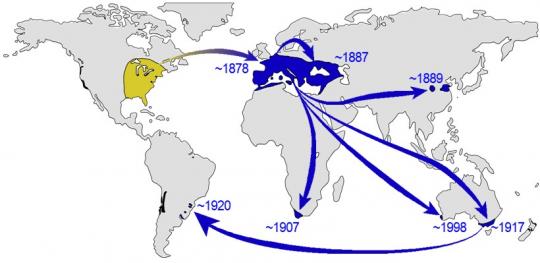Populations genomics
To understand how adaptation and demography affect the genetic diversity of P. viticola populations, we have implemented some population genomics approachs by resequencing strains. This approach allow to address the following issues :
-
Demographic history of the invasion of P. viticola in Europe : On the trail of late blight in Europe
This work provides the keys for a better understanding of Plasmopara viticola history, and therefore its evolution, is a lever for combating this parasite, the source of the majority of fungicide treatments on vines.Researchers used a multidisciplinary approach to answer these questions, and discovered that the first contamination of grapevines in Europe took place 150 years ago, from a single species of downy mildew: that infecting the wild grapevine Vitis aestivalis. Scientists then followed the trail to find out how it came to infect French vineyards. Their study suggests that the pathogen was introduced when wild American vines were imported to combat powdery mildew and phylloxera1. In fact, France, first affected by phylloxera, intensified varietal innovation by incorporating disease resistance from wild American vines into cultivated vines (V. vinifera). In turn, European cultivated vines then served as a source for the introduction of the disease to vineyards around the world.From the 19th century onwards, modern vineyards around the world took France as their model. The country exported its phylloxera-resistant hybrids and rootstocks, in particular European grape varieties from the most renowned regions of the time (Cabernet, Merlot, Chardonnay, Syrah, etc.). And it was through this international trade that grapevine mildew spread.These scientific studies provide new insights into grapevine downy mildew, particularly in terms of its spread around the world. It also highlights the importance of regulations governing the international transport of plant material, to prevent other downy mildew species from being introduced into our vineyards.

Europe as a bridgehead in the worldwide invasion history of grapevine downy mildew, Plasmopara viticola. Current Biology, 31, 2155-2166.e2154, https://doi.org/10.1016/j.cub.2021.03.009
- Genetic determinism of Mating Types : A first description of the locus of sexual type determinism identified inin an oomycete
Sex types" are self-incompatibility systems that promote cross-fertilization in plants, fungi and oomycetes.
By associating genomic variations with the sexual types identified by crossing a large number of individuals, the researchers showed that one sexual type (P1) was homozygous (Mat-a/Mat-a), while the other (P2) was heterozygous[3] (Mat-a/Mat-b). The sex-type locus comprises 40 genes, one of which may act as a hormone receptor.

Sex-type genetic system in grapevine downy mildewSex-type genetic system in grapevine downy mildew
A fundamental discovery, and prospects in the fight against mildew
These discoveries have fundamental implications for our understanding of sex-type evolution, as they reveal a unique determinism involving heterozygosity asymmetry similar to that of sex chromosomes (such as the mammalian XY system). This system is very different from other known sex-type systems in plants, algae and fungi. With this discovery, a new means of combating grapevine downy mildew could be envisaged, consisting in targeting the sexual phase of the pathogen. Limiting the success of sexual reproduction reduces the intensity of the following year's epidemics. The ambition of the scientists behind this research is to develop a process for disrupting the sexual phase, for example by saturating the environment with hormones specific to the recognition of sexual types.
Identification of the first Oomycete mating-type locus sequence in the grapevine downy mildew pathogen, Plasmopara viticola. Current Biology, 30, 3897-3907, https://doi.org/10.1016/j.cub.2020.07.057
- Adaptation to disease-resistant grapevine cultivars
- Molecular bases of pathogenicity : virulence and agressivity